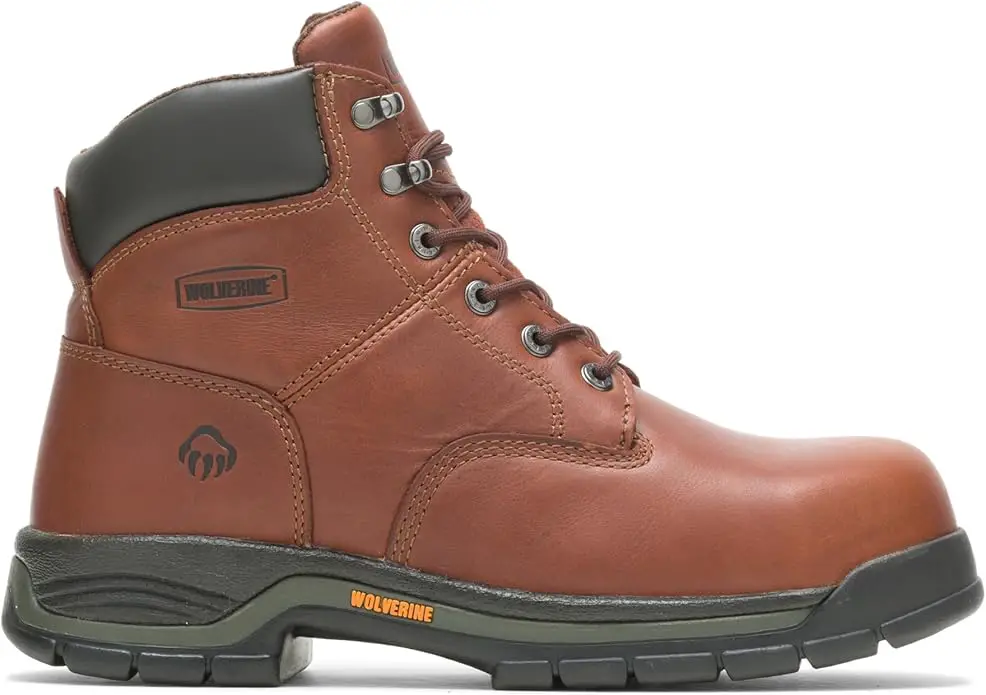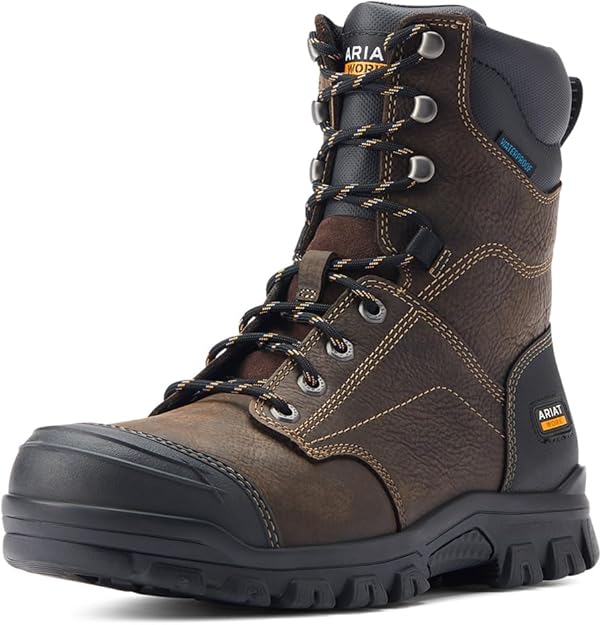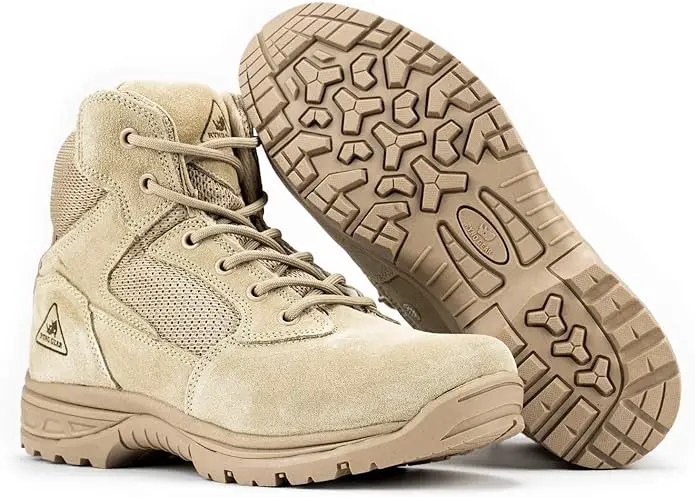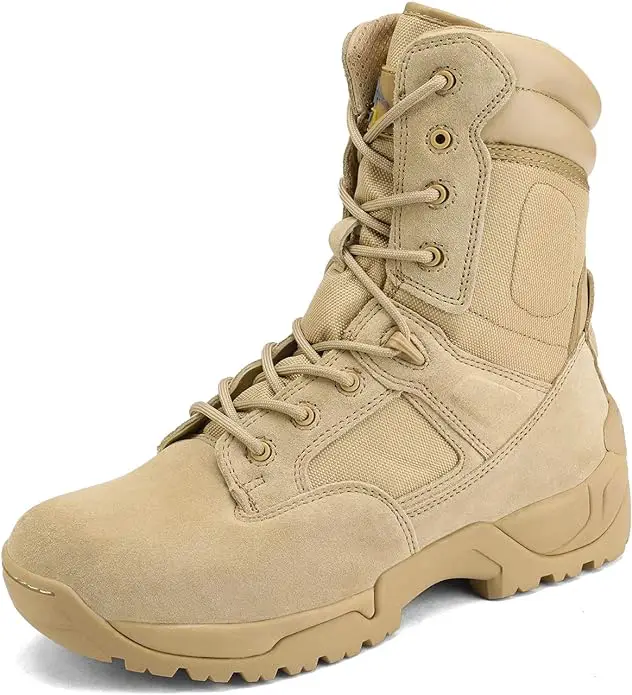When it comes to boots, height is one of the most crucial factors to consider. Two popular options are 6-inch and 8-inch boots, each offering unique advantages and suitable for different needs and preferences. In this comprehensive guide, we’ll delve into the nuances of these two boot heights, exploring their characteristics, applications, and factors to consider when choosing between them.
Understanding Boot Heights
Before we dive into the specifics of 6-inch and 8-inch boots, let’s first understand what these measurements refer to.
Boot Height: The height of a boot is measured from the bottom of the sole to the top of the shaft, where your leg enters the boot.
6-inch boots:
Wolverine Mens Harrison Lace Up 6 Inch Boot

- Hard-working boot featuring contrast cushioned collar and logos at tongue and outstep panels
Removable full-cushion insole
Moisture managing mesh lining
Wolverine cemented sole construction
These boots typically have a shaft height of approximately 6 inches (15.24 cm) from the sole.
8-inch boots:
Ariat mens Treadfast 8″ Waterproof Boots

- Get the job done with Treadfast, built for outdoor work or indoors. Designed with an outsole that performs on a variety of surfaces, it’s a great choice for construction, factory, warehouse, farm and ranch work.
As the name suggests, these boots feature a shaft height of around 8 inches (20.32 cm) from the sole.
It’s important to note that these measurements can vary slightly across different brands and styles, but they provide a general reference point for comparison.
Factors to Consider
When choosing between 6-inch and 8-inch boots, several factors come into play, including:
- Intended Use: The primary purpose for which you’ll be wearing the boots will significantly influence your choice. Different activities and environments may call for varying levels of ankle support, protection, and mobility.
- Climate and Weather Conditions: The height of the boot can impact how well it handles different weather conditions, such as rain, snow, or extreme temperatures.
- Personal Preference and Style: While functionality is crucial, personal style and aesthetic preferences also play a role in selecting the right boot height.
- Fit and Comfort: The height of the boot can affect its overall fit and comfort, especially for those with larger or more slender calves.
Let’s explore how 6-inch and 8-inch boots compare across these factors.
6-Inch Boots: Pros and Cons
RYNO GEAR 6″ Coolmax Tactical Combat Breathable Side Zip Boots

- Features a combination of leather and ballistic nylon for comfort and durability
CoolMax lining/Padded collar
Contrast stitching detail
Breathable mesh lining
Removable shock absorbent insoles for your comfort
Pros:
- Mobility and Flexibility: 6-inch boots generally offer more mobility and flexibility around the ankle compared to taller boots. This can be advantageous for activities that require frequent bending, kneeling, or climbing.
- Easier to Put On and Take Off: With a shorter shaft height, 6-inch boots are typically easier to slip on and off, making them a convenient choice for situations where you need to remove your boots frequently.
- Versatility: 6-inch boots strike a balance between style and functionality, making them suitable for a wide range of activities, from casual wear to light outdoor pursuits.
- Breathability: The shorter shaft height can promote better airflow and breathability, which can be beneficial in warmer climates or during strenuous activities.
Cons:
- Limited Ankle Support: Compared to taller boots, 6-inch boots may provide less ankle support, which could be a concern for individuals with weak or injured ankles or those engaging in demanding activities that require extra stability.
- Less Protection: The shorter shaft height offers less protection against environmental hazards, such as water, mud, or debris, which may be a consideration for those working or engaging in outdoor activities in challenging conditions.
- Limited Insulation: While the shorter shaft height can improve breathability, it may also provide less insulation, making 6-inch boots less suitable for extremely cold or snowy conditions.
8-Inch Boots: Pros and Cons
NORTIV 8 Men’s Military Tactical Boots

- Ankle-high protection wraps & supports the ankles.YKK side zipper with hook-loop strap closure is easy to take on/off.
Pros:
- Increased Ankle Support: 8-inch boots extend higher up the leg, providing superior ankle support and stability. This can be beneficial for activities that involve carrying heavy loads, hiking on uneven terrain, or situations where ankle protection is crucial.
- Enhanced Protection: The taller shaft height offers better protection against environmental hazards, such as water, mud, debris, or even snake bites in certain outdoor environments.
- Insulation and Warmth: The extended shaft can provide better insulation, making 8-inch boots a preferred choice for cold weather conditions or outdoor activities in snowy or icy environments.
- Durability: The taller shaft and generally more robust construction of 8-inch boots can contribute to increased durability and longevity, especially for those working in demanding environments or engaging in rugged outdoor activities.
Cons:
- Reduced Mobility: The taller shaft height of 8-inch boots can limit ankle mobility and flexibility, which may be a concern for activities that require frequent bending or kneeling.
- Potential for Chafing and Discomfort: Depending on the fit and the individual’s calf size, the taller shaft can sometimes cause chafing or discomfort, especially during extended wear or strenuous activities.
- Increased Weight: 8-inch boots tend to be heavier than their 6-inch counterparts due to the additional material used in the shaft. This added weight can contribute to fatigue during prolonged wear or activities involving significant walking or hiking.
- Difficulty Getting On and Off: The taller shaft height can make it more challenging to slip 8-inch boots on and off, which may be inconvenient in situations where frequent boot removal is required.
Applications and Environments
Understanding the intended use and environment is crucial when choosing between 6-inch and 8-inch boots. Here are some common applications and environments where each boot height may be more suitable:
6-Inch Boots:
- Casual Wear: 6-inch boots are a versatile choice for everyday casual wear, providing a stylish and comfortable option for various settings.
- Light Outdoor Activities: Activities such as hiking on well-maintained trails, camping, or light yard work can benefit from the mobility and breathability of 6-inch boots.
- Warm Weather Conditions: The shorter shaft height and improved breathability make 6-inch boots a suitable choice for warmer climates or activities that may cause excessive sweating.
8-Inch Boots:
- Outdoor Work and Construction: Jobs that involve working in rugged environments, such as construction sites, forestry, or oil and gas operations, often benefit from the enhanced protection and stability offered by 8-inch boots.
- Hiking and Backpacking: For more demanding hikes or backpacking trips on uneven terrain, the increased ankle support and protection of 8-inch boots can be advantageous.
- Cold Weather and Snow: The taller shaft height and improved insulation make 8-inch boots a preferred choice for cold weather conditions, snow, or icy environments.
- Hunting and Tactical Applications: Activities like hunting or tactical operations may require the added protection and stability provided by 8-inch boots, especially in challenging terrain or environments.
It’s important to note that these are general guidelines, and individual preferences and specific activity requirements may vary. It’s always advisable to consider your personal needs and consult with experts or experienced users when making a decision.
Fit and Comfort Considerations
Proper fit and comfort are essential for any boot, regardless of height. Here are some key factors to consider when trying on 6-inch and 8-inch boots:
Calf Fit:
- 6-Inch Boots: The shorter shaft height generally provides a more accommodating fit for individuals with larger or more muscular calves.
- 8-Inch Boots: Those with slender or narrow calves may find 8-inch boots more comfortable, as the taller shaft can provide a snugger fit.
Ankle and Heel Lockdown:
- Both 6-inch and 8-inch boots should provide a secure fit around the ankle and heel to prevent excessive movement and potential blisters or discomfort.
Break-in Period:
- Taller boots, such as 8-inch models, may require a longer break-in period to ensure proper comfort and prevent chafing or hotspots.
Insoles and Arch Support:
- Investing in high-quality insoles or arch supports can significantly improve the overall comfort and support of both 6-inch and 8-inch boots, especially for those who spend extended periods on their feet.
Lacing Systems:
- Different lacing systems, such as speed hooks or lace locks, can help achieve a more customized and secure fit, regardless of boot height.
It’s always recommended to try on boots in person, if possible, and walk around the store to assess the fit and comfort before making a purchase. Additionally, consulting with knowledgeable boot fitters or experienced users can provide valuable insights and ensure you make an informed decision tailored to your specific needs and preferences.
Maintenance and Care

Proper maintenance and care are crucial for extending the life and performance of your boots, whether 6-inch or 8-inch. Here are some general tips:
Cleaning and Conditioning:
- Regular cleaning and conditioning of the leather or other materials can help maintain the boot’s appearance and prevent premature cracking or drying.
- Use appropriate cleaning products and conditioners specific to the boot material, and follow the manufacturer’s instructions.
Waterproofing:
- Applying a waterproof treatment or sealant can help protect your boots from water, snow, and moisture, ensuring they remain dry and comfortable in wet conditions.
- Reapply waterproofing as recommended or when the boots begin to lose their water repellency.
Sole Replacement:
- Over time, the soles of your boots may wear down, compromising traction and stability.
- Consider having the soles replaced by a professional cobbler or boot repair service when necessary.
Storage and Drying:
- Always store your boots in a cool, dry place, away from direct sunlight or heat sources.
- After wearing your boots in wet conditions, ensure they are properly dried before storing to prevent mold or mildew growth.
By following these maintenance and care guidelines, you can extend the lifespan of your 6-inch or 8-inch boots and ensure they continue to provide reliable performance and comfort for years to come.
Conclusion
When it comes to choosing between 6-inch and 8-inch boots, there is no one-size-fits-all solution. Both options offer unique advantages and cater to different needs and preferences. Whether you prioritize mobility, ankle support, protection, or insulation, understanding the nuances of these boot heights will help you make an informed decision tailored to your specific requirements.
Remember, the key to finding the perfect boot lies in considering your intended use, personal preferences, and ensuring a proper fit and comfort level. Don’t hesitate to seek advice from experienced boot enthusiasts or professionals to guide you through the selection process.
Ultimately, the right boot height is the one that aligns with your lifestyle, activities, and personal style, providing the perfect balance of function and fashion. Embrace your choice, whether it’s the versatile 6-inch or the rugged 8-inch, and embark on your adventures with confidence and comfort.
Read More Articles
- Top 10 Best Rattlesnake Boots For Men in 2024
- Danner Sharptail Snake Boots Review: The Ultimate Guide for 2024
- Snake Boots vs Chaps: Which Offers Better Protection?
- Danner San Angelo Snake Boot Review (2024)
- Snake Boots for Turkey Hunting: The Complete Guide
- Best Snow Boots for Managing Lymphedema in 2024

More Stories
The Top 8 Best Hunting Boots for Saddle Hunting in 2024
Hiking Boots vs Hunting Boots: How to Decide Between the Two for Your Needs
The 5 Best Hiking Boots under $100 for 2024